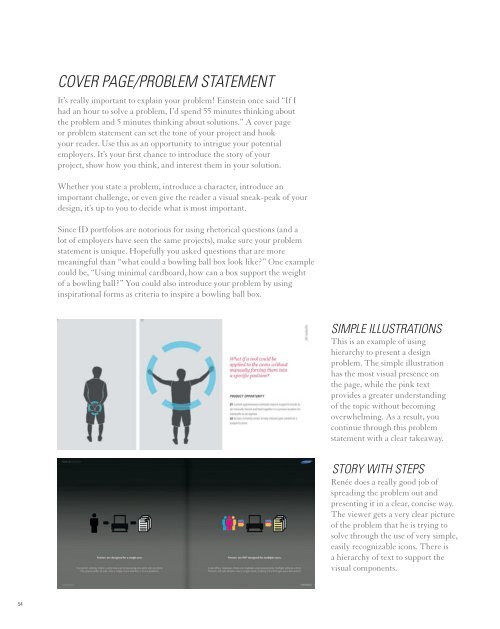HIRE ME?!
HIRE ME?!
HIRE ME?!
Create successful ePaper yourself
Turn your PDF publications into a flip-book with our unique Google optimized e-Paper software.
54<br />
COVER pAgE/pROBLEM STATE<strong>ME</strong>NT<br />
It’s really important to explain your problem! Einstein once said “If I<br />
had an hour to solve a problem, I’d spend 55 minutes thinking about<br />
the problem and 5 minutes thinking about solutions.” A cover page<br />
or problem statement can set the tone of your project and hook<br />
your reader. Use this as an opportunity to intrigue your potential<br />
employers. It’s your fi rst chance to introduce the story of your<br />
project, show how you think, and interest them in your solution.<br />
Whether you state a problem, introduce a character, introduce an<br />
important challenge, or even give the reader a visual sneak-peak of your<br />
design, it’s up to you to decide what is most important.<br />
Since ID portfolios are notorious for using rhetorical questions (and a<br />
lot of employers have seen the same projects), make sure your problem<br />
statement is unique. Hopefully you asked questions that are more<br />
meaningful than “what could a bowling ball box look like?” One example<br />
could be, “Using minimal cardboard, how can a box support the weight<br />
of a bowling ball?” You could also introduce your problem by using<br />
inspirational forms as criteria to inspire a bowling ball box.<br />
SIMpLE ILLUSTRATIONS<br />
This is an example of using<br />
hierarchy to present a design<br />
problem. The simple illustration<br />
has the most visual presence on<br />
the page, while the pink text<br />
provides a greater understanding<br />
of the topic without becoming<br />
overwhelming. As a result, you<br />
continue through this problem<br />
statement with a clear takeaway.<br />
STORY WITH STEpS<br />
Renée does a really good job of<br />
spreading the problem out and<br />
presenting it in a clear, concise way.<br />
The viewer gets a very clear picture<br />
of the problem that he is trying to<br />
solve through the use of very simple,<br />
easily recognizable icons. There is<br />
a hierarchy of text to support the<br />
visual components.


